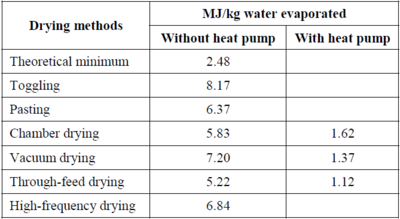Difference between revisions of "Drying of hides and skins"
| Line 33: | Line 33: | ||
In order to avoid energy losses for reheating, drying installations should be run as continuously | In order to avoid energy losses for reheating, drying installations should be run as continuously | ||
as possible. The heat capacity and heat transmission of new installations are as low as possible. | as possible. The heat capacity and heat transmission of new installations are as low as possible. | ||
| − | A system for the use of heat pumps in drying exists, developed in France | + | A system for the use of heat pumps in drying exists, developed in France. |
Without the use of a heat pump, the energy consumed is mainly thermal energy. The only | Without the use of a heat pump, the energy consumed is mainly thermal energy. The only | ||
exception is high frequency drying, which uses electrical energy exclusively. Due to the high | exception is high frequency drying, which uses electrical energy exclusively. Due to the high | ||
Revision as of 15:59, 23 August 2016
Back to Subsection DC leather
General description
The objective of drying is to dry the leather whilst optimising the quality and area yield. There is a wide range of drying techniques and some may be used in combination. Each technique has a specific influence on the characteristics of the leather.
Drying techniques include samming, setting, hang drying, vacuum drying, toggle drying and paste drying. Generally samming and setting are used to reduce the moisture content mechanically before another drying technique is used to dry the leather further. After drying, the leather may be referred to as crust. Crust is a tradable intermediate product.
Improved drying techniques
Description
Low temperature drying (LTD) machines are available with reduced energy consumption, although in some cases they can lengthen the drying process (e.g. LTD drying tunnels may require all night to dry leathers, compared with 4 hours in conventional hang drying tunnels, but may have three times the capacity).
Considerable reductions in energy consumption can be achieved by optimising the mechanical dewatering processes prior to drying.
Temperature and humidity during the drying need to be carefully controlled. Elimination of the greatest possible amount of water in samming may mean energy savings of 0.5 – 1 GJ/t raw hide in drying. Keeping drying temperature low and drying time and amount of exhaust air at the necessary minimum will keep heat losses to a minimum (although, consideration of leather properties will have priority).
In order to avoid energy losses for reheating, drying installations should be run as continuously as possible. The heat capacity and heat transmission of new installations are as low as possible. A system for the use of heat pumps in drying exists, developed in France. Without the use of a heat pump, the energy consumed is mainly thermal energy. The only exception is high frequency drying, which uses electrical energy exclusively. Due to the high costs of electrical energy and to the high investment cost, this method has only gained a limited acceptance.
It is obvious the natural drying of the leather is the method with the lowest energy consumption but it is impractical for much of the year in many parts of Europe due to climatic conditions. These include low temperatures, high rainfall and the associated humidity, combined with unpredictable variations in all these factors.
For finish drying, infrared heating is an energy-saving method
Reduced energy use may be achieved.
Environmental performance and operational data
For example, a study carried out on a paste drying unit and on a hang drying unit showed that the overall thermal efficiency of the first machine was approximately 2.9 kg of steam per unit of water evaporated, whereas the second machine required approximately 2.5 kg of steam per unit of water evaporated. The poorer performance of the paste drying unit was found to be related to 30 % heat losses due to leaks, and insufficient insulation of the unit. In this case, energy savings were achieved by improving the insulation of the unit, reducing heat losses and optimising the operating procedures.
The figures given in Table 1 are for the energy consumption of various drying methods, without and with the use of heat pumps.
Table 1: Energy consumption of various drying methods
Driving force for implementation
The driving forces are to reduce energy costs and to meet energy use targets.
Example plants
Tanneries in France have been reported to be implementing the heat pump technique. Reference literature [56, Pearson et al. 1999] [105, Pfisterer 1986].
Source: (BAT) Reference Document for the Tanning of Hides and Skins, 2013
Back to Subsection DC leather
